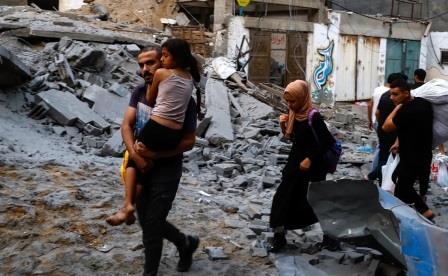Exchanges of fire in the towns and communities in Israel surrounding Gaza continued for the second consecutive day following the infiltration of members of Palestinian armed groups into Israel. Palestinian armed groups in Gaza continued rocket fire into Israel. Simultaneously, Israeli continued air, naval and land strikes throughout the night and morning.
As of 20:00, according to Israeli sources, at least 677 Israelis, including possibly also foreign nationals, were killed and at least 2,000 people were injured, making it the deadliest attack in Israel in decades. Media reports estimate the number killed to be much higher. According to Israeli sources, more than 50 Israeli forces personnel and Israeli civilians, including women and children, were captured and forcibly taken into Gaza.
As of 20:00, according to the Ministry of Health in Gaza, at least 413 Palestinians have been killed and 2,300 others injured. An additional 13 Palestinians, including one child, were killed by Israeli forces in the West Bank.
As of 21:00, 123,538 Palestinians had been displaced in Gaza.
HUMANITARIAN OVERVIEW
Israeli airstrikes and shelling have targeted houses and apartment buildings in Gaza. In some cases, residential buildings were reportedly struck without warning for residents to evacuate. Notably, four large residential towers with multiple floors of residential units (Palestine, Al-Hashim, Wattan, and Al Aklouk) in Gaza city were completely destroyed. Israeli forces reportedly provided prior warnings in these cases and there were no fatalities reported from these incidents. According to the Gaza Ministry of Public Works and Housing, 159 housing units have been destroyed, while 1,210 have suffered severe damage.
Six health care workers were killed and four injured by Israeli airstrikes that also damaged seven health care facilities and nine ambulances. Damage to WASH related facilities from Israeli airstrikes has undermined the provision of water, sanitation, and hygiene (WASH) services to over 400,000 people.
The hostilities have led to internal displacement. More than 17,500 families, comprising over 123,538 people, have been internally displaced in Gaza, mostly due to fear, protection concerns and the destruction of their homes. Out of the internally displaced persons (IDPs), UNRWA estimates 73,538 people are sheltering in 64 schools, some of which are designated emergency shelters. The UNRWA designated emergency shelters in the Gaza Strip were activated to host the displaced and provide them with urgent assistance.
Erez and Kerem Shalom crossings remain closed due to the escalation. Among those unable to exit were 130 referred patients and their accompaniers with scheduled appointments at medical facilities in the West Bank, including East Jerusalem, or in Israel. The Rafah crossing with Egypt were open today and allowed 100 truckloads of food items, 30 truckloads of fuel, and 70 truckloads of construction materials to cross.
In the evening of 7 October, Israeli authorities ceased supplying electricity to the Gaza strip, reducing the hours of electricity to 3-4 per day. The Gaza Power Plant is currently the only source of power and could run out of fuel within days.
In the West Bank, including East Jerusalem, confrontations with Israeli forces have persisted for the second consecutive day in multiple locations. Between 7 and 8 October, as of 21:00, 13 Palestinians, including a 12-year-old child, were killed by Israeli forces in various areas across the West Bank. One of the Palestinians was killed while attacking or allegedly attempting to stab a member of the Israeli forces near Al Lubban al Gharbiyeh (Ramallah). Another individual was shot and killed during an armed clash between Palestinians and Israeli forces near the Deir Sharaf checkpoint (Nablus). The remaining eleven Palestinians were all killed during demonstrations in solidarity with the Gaza Strip and other confrontations involving stone throwing.
PRCS reported that since 7 October and as of 8 October at 12:00pm, they treated 191 Palestinian injuries in the West Bank including East Jerusalem, of which 38 from live ammunition, 26 from rubber bullets, 101 were treated for teargas inhalation, eight from shrapnel, and 18 were physically assaulted.
Israeli settlers injured three additional Palestinians; one by live ammunition, another by a rubber bullet, and a third was stabbed. On 7 October, settlers reportedly from Itamar attacked Palestinian farmers in Yanun (Nablus), injuring one farmer and damaging five vehicles. On that day, settlers reportedly from Esh Kodesh closed the road connecting Qusra and Jalud (Nablus), firing live ammunition and injuring a Palestinian man while also setting fire to three agricultural rooms. Additionally, on the same day, a Palestinian man was stabbed and injured in Yasuf (Salfit) during a settler attack involving an attempt to set fire to three Palestinian houses.
The Israeli authorities have continued to impose multiple movement restrictions, including the closure of several checkpoints and entrances to towns and cities in the West Bank. This includes the Shu’fat Refugee Camp and Beit Iksa town both in Jerusalem, which remain under closure for the second consecutive day, restricting the movement of more than 27,000 Palestinians from accessing essential services, including healthcare. Additionally, Israeli forces closed all checkpoints segregating part of the Israeli-controlled area of Hebron (H2) from the remainder of the city, impeding the movement of 7,000 Palestinian residents of the area, including from accessing essential services.
A general strike was announced in the West Bank, resulting in the closure of all markets, shops, and education facilities.
Humanitarian needs across the OPT continue to rise, the response to which is impeded by a current lack of access.
review the full Report by OCHA
| Themes |
| • Destruction of habitat • Human rights • Norms and standards • People under occupation • Regional |














